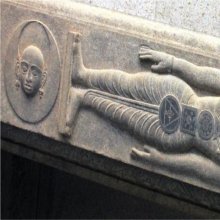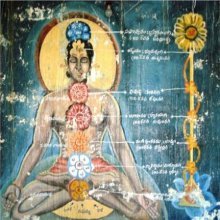Shatcakra, Ṣaṭcakra, Shash-cakra: 7 definitions
Introduction:
Shatcakra means something in Hinduism, Sanskrit. If you want to know the exact meaning, history, etymology or English translation of this term then check out the descriptions on this page. Add your comment or reference to a book if you want to contribute to this summary article.
The Sanskrit term Ṣaṭcakra can be transliterated into English as Satcakra or Shatcakra, using the IAST transliteration scheme (?).
Alternative spellings of this word include Shatchakra.
Images (photo gallery)
In Hinduism
Shilpashastra (iconography)
Source: DSpace at Pondicherry: Siddha Cult in Tamilnadu (sculpture)Ṣaṭcakra (षट्चक्र).—In the ceiling beam of the Puthumaṇḍapa of Tiruvotriyūr Śiva temple, the body of a standing human Figure the ṣaṭ-cakras are depicted in the respective places of his body starting from mūlādhāra to sahasrāra. To his left (iḍa) moon is depicted and to his right (piṅgala) Sun is depicted. Though it seems to be of a later period, this kind of sculpture is not found in any other temple.

Shilpashastra (शिल्पशास्त्र, śilpaśāstra) represents the ancient Indian science (shastra) of creative arts (shilpa) such as sculpture, iconography and painting. Closely related to Vastushastra (architecture), they often share the same literature.
Shaktism (Shakta philosophy)
Source: Google Books: ManthanabhairavatantramṢaṭcakra (षट्चक्र) [=Cakraṣaṭka?] refers to “six wheels” and represents an example of the ‘six parts’ (Ṣaṭprakārā, cf. Ṣaṭka) [of the Goddess], according to the Manthānabhairavatantra, a vast sprawling work that belongs to a corpus of Tantric texts concerned with the worship of the goddess Kubjikā.—The Six Wheels (ṣaṭcakra) are the six parts. The inner body of all living beings is modeled on that of the deity. Consisting of the Six Wheels, it is the Body of Thunder or the Self of Thunder and is said to be the “Kula with six parts” of all embodied beings. Also called the six sheaths, these six are “the great ocean of the six parts” (ṣaṭprakāra-mahārṇava). The Ciñcinīmatasārasamuccaya calls them collectively (the reality with) six parts (ṣaṭprakāra) and lists where they are located in the body.
Note: Various entities are coupled with projections of the six Wheels (ṣaṭcakra). These include six sacred seats with their six goddesses and Siddhas, six Liṅgas, six Yoginīs and the six lineages said to have been founded by Matsyendranātha through his six disciples. [...]

Shakta (शाक्त, śākta) or Shaktism (śāktism) represents a tradition of Hinduism where the Goddess (Devi) is revered and worshipped. Shakta literature includes a range of scriptures, including various Agamas and Tantras, although its roots may be traced back to the Vedas.
Yoga (school of philosophy)
Source: archive.org: Yoga Aphorisms of Patanjali with Bhoja VrittiṢaṭcakra (षट्चक्र) is the name of a work dealing with the Yoga system of Philosophy. It deals with—The six principal parts of the body which should be meditated upon. Cf. Buhler’s Guzarat Catalogue. IV.

Yoga is originally considered a branch of Hindu philosophy (astika), but both ancient and modern Yoga combine the physical, mental and spiritual. Yoga teaches various physical techniques also known as āsanas (postures), used for various purposes (eg., meditation, contemplation, relaxation).
Languages of India and abroad
Sanskrit dictionary
Source: Cologne Digital Sanskrit Dictionaries: Shabda-Sagara Sanskrit-English DictionaryṢaṭcakra (षट्चक्र).—n.
(-kraṃ) The six mystical circles of the body, (in Tantra.)
Source: Cologne Digital Sanskrit Dictionaries: Aufrecht Catalogus CatalogorumṢaṭcakra (षट्चक्र) as mentioned in Aufrecht’s Catalogus Catalogorum:—on the six mystic centres or circles connected with particular parts of the body. The meditation on these procures transcendant power. These circles often represented as lotuses are called mūlādhāra, svādhiṣṭhāna, maṇipūra, anāhata, viśuddha, ājñā. Sometimes a seventh named sahasradala is added. B. 4, 6. Proceed. Asb. 1871, 282 (and—[commentary]).
Source: Cologne Digital Sanskrit Dictionaries: Monier-Williams Sanskrit-English Dictionary1) Ṣaṭcakra (षट्चक्र):—[=ṣaṭ-cakra] [from ṣaṭ > ṣaṣ] n. sg. the six mystical circles of the body (mūlādhāra, svādhiṣṭhāna, maṇipūra, an-āhata, viśuddha, ājñākhya), [Pañcarātra]
2) [v.s. ...] Name of [work]
[Sanskrit to German]
Sanskrit, also spelled संस्कृतम् (saṃskṛtam), is an ancient language of India commonly seen as the grandmother of the Indo-European language family (even English!). Closely allied with Prakrit and Pali, Sanskrit is more exhaustive in both grammar and terms and has the most extensive collection of literature in the world, greatly surpassing its sister-languages Greek and Latin.
Kannada-English dictionary
Source: Alar: Kannada-English corpusṢaṭcakra (ಷಟ್ಚಕ್ರ):—[noun] (pl.) the six mystical circles in the human body, which has the latent energy, when aroused, passes through and reach the pinnacle at which it merges with the universal Energy.
Kannada is a Dravidian language (as opposed to the Indo-European language family) mainly spoken in the southwestern region of India.
See also (Relevant definitions)
Partial matches: Sat, Cakra, Shash.
Starts with: Shatcakrabheda, Shatcakrabhedatippani, Shatcakrabhedavivrititika, Shatcakradhyanapaddhati, Shatcakradipika, Shatcakradisamgraha, Shatcakrakrama, Shatcakram, Shatcakranilaya, Shatcakranirupana, Shatcakraprabheda, Shatcakrasvarupa, Shatcakravivrititika.
Full-text (+4): Shatcakradhyanapaddhati, Shatcakrabheda, Shatcakrakrama, Shatcakram, Shatcakrabhedavivrititika, Shatcakradipika, Shatcakraprabheda, Shatcakranilaya, Shatcakravivrititika, Shatcakrasvarupa, Shatcakrabhedatippani, Shatcakradisamgraha, Shatcakropanishaddipika, Shatkamala, Shadadharacakra, Shaducakra, Shadadhara, Shatkosha, Cakra, Cakrashatka.
Relevant text
Search found 9 books and stories containing Shatcakra, Ṣaṭcakra, Shash-cakra, Sat-cakra, Satcakra, Shat-cakra, Ṣaṣ-cakra, Ṣaṣcakra, Ṣaṭ-cakra, Sascakra, Sas-cakra; (plurals include: Shatcakras, Ṣaṭcakras, cakras, Satcakras, Ṣaṣcakras, Sascakras). You can also click to the full overview containing English textual excerpts. Below are direct links for the most relevant articles:
Shat-cakra-nirupana (the six bodily centres) (by Arthur Avalon)
Verse 24 < [Section 4]
Summary of the Ājñā Cakra (verses 31a-38) < [Section 6]
Serpent Power (Kundalini-shakti), Introduction (by Arthur Avalon)
Cidgaganacandrika (study) (by S. Mahalakshmi)
Verse 97 [Piṇḍamantra] < [Chapter 3 - Third Vimarśa]
Verse 140 [Ṣaṭcakra Mānasa Sthiti] < [Chapter 3 - Third Vimarśa]
Verse 96 [Praṇava produced by Cakrapañcaka in Kuṇḍalinī] < [Chapter 3 - Third Vimarśa]
Paduka-panchaka (the five-fold footstool) (by Arthur Avalon)
Lalitopakhyana (Lalita Mahatmya) (by G.V. Tagare)
Gitartha Samgraha (critical Study) (by Partha Sarathi Sil)
1. Significance of the Saṅgraha ślokas of the Gītārthasaṅgraha < [Chapter 4 - Critical Study of the Gītārthasaṅgraha]

